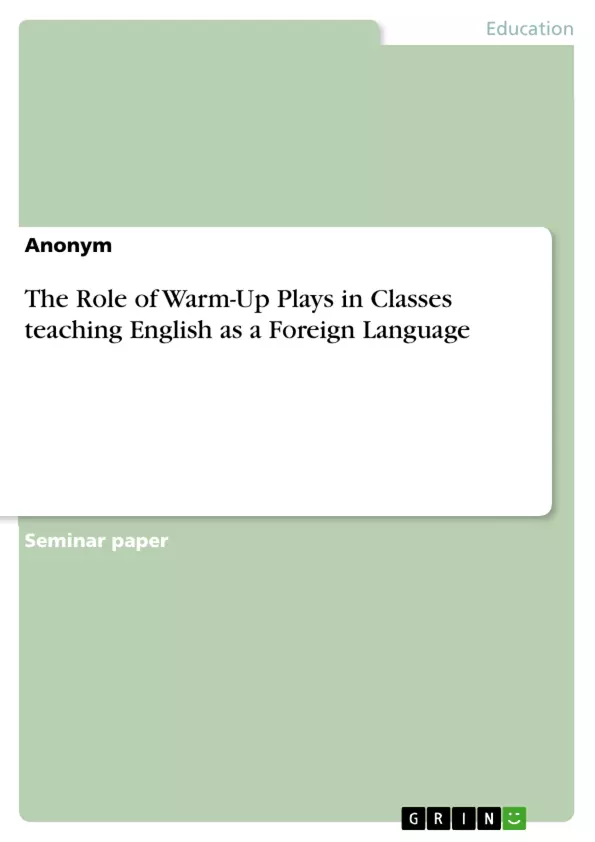Knowing that warm-ups are supposed to be important in the context of classrooms that are teaching English as a foreign language, this thesis will analyse its relevance in-depth. By doing so, the main question of this work will be: Which Role Do Warm-Ups play in English as foreign language-Lessons? Getting to know how and why these activities are crucial for the affected students is surely interesting and beneficial for teachers-to-be as they need to focus on organising their lessons and making their students learning progress top priority.
In order to find an answer to the main issue of this work, the first step will be to examine the warm-up as an own lesson phase. Secondary, the positive effects of using such a lesson phase will be described. Lastly, important instructions for the use of warm-ups will be given. In the end, the most important aspects of the analysis will be summarised in a conclusion.
Inhaltsverzeichnis (Table of Contents)
- Introduction
- The Role of Warm-ups in EFL-Lessons
- The Warm-up as a Lesson Phase
- The Positive Effects of Warm-Ups
- Important Instructions for the Use of Warm-Ups
- Conclusion
Zielsetzung und Themenschwerpunkte (Objectives and Key Themes)
This thesis aims to analyze the relevance of warm-up activities in English as a Foreign Language (EFL) lessons, specifically focusing on their role in promoting student competence and effective lesson planning. The main research question is: "Which Role Do Warm-Ups Play in EFL-Lessons?".
- The warm-up as a distinct lesson phase and its integration within broader lesson planning models.
- The various positive effects of warm-up activities on student learning and engagement.
- Practical guidelines and considerations for effective implementation of warm-up activities in EFL classrooms.
- The alignment of warm-up activities with contemporary competence-oriented teaching approaches.
- The application of warm-up strategies to students in grades five to seven.
Zusammenfassung der Kapitel (Chapter Summaries)
Introduction: This introductory chapter establishes the significance of warm-up activities in EFL classrooms, highlighting the lack of extensive discussion on this topic in English didactics despite its practical importance. It emphasizes the complexity of EFL lesson planning and the need for structured approaches to develop diverse student competences. The chapter introduces the main research question and outlines the thesis's structure, including an examination of warm-ups as a lesson phase, their positive effects, and practical instructions for their use. A supplementary video focusing on concrete warm-up methods is also mentioned.
The Role of Warm-ups in EFL-Lessons: This chapter delves into the role of warm-ups within EFL lessons. It begins by examining the warm-up as a distinct lesson phase, contrasting it with the "lead-in" and discussing its place within broader lesson planning models. The chapter explores the shift towards competence-oriented teaching and how warm-ups can contribute to the development of key competences in reading, writing, listening, and speaking. It connects the importance of lesson planning with teacher training standards and emphasizes the flexibility needed in adapting lesson plans to specific learning objectives and student needs.
Schlüsselwörter (Keywords)
Warm-ups, EFL, lesson planning, competence-oriented teaching, student engagement, grades 5-7, English didactics, methodology.
Frequently Asked Questions: A Comprehensive Language Preview
What is the main topic of this language preview?
This preview focuses on the role and importance of warm-up activities in English as a Foreign Language (EFL) lessons for students in grades five to seven. It examines warm-ups as a distinct lesson phase, their positive effects on student learning and engagement, and provides practical guidelines for their effective implementation.
What are the key objectives of the research presented in this preview?
The main research question is: "Which Role Do Warm-Ups Play in EFL-Lessons?". The preview aims to analyze the relevance of warm-up activities in promoting student competence and effective lesson planning. It explores the integration of warm-ups within broader lesson planning models, their positive effects on student learning, practical guidelines for implementation, and their alignment with competence-oriented teaching approaches.
What are the key themes explored in this preview?
Key themes include the warm-up as a distinct lesson phase, the positive effects of warm-up activities on student learning and engagement, practical guidelines and considerations for effective implementation, the alignment of warm-up activities with contemporary competence-oriented teaching approaches, and the application of warm-up strategies to students in grades five to seven.
What is covered in the "Introduction" chapter?
The introduction highlights the significance of warm-up activities in EFL classrooms, notes the lack of extensive discussion on this topic in English didactics, emphasizes the complexity of EFL lesson planning, and introduces the main research question and the thesis's structure. It also mentions a supplementary video on concrete warm-up methods.
What is discussed in the chapter on "The Role of Warm-ups in EFL-Lessons"?
This chapter examines the warm-up as a distinct lesson phase, contrasting it with the "lead-in" and discussing its place within broader lesson planning models. It explores the shift towards competence-oriented teaching and how warm-ups contribute to developing key competences. It connects lesson planning with teacher training standards and emphasizes the flexibility needed in adapting lesson plans.
What are the key words associated with this research?
Key words include: Warm-ups, EFL, lesson planning, competence-oriented teaching, student engagement, grades 5-7, English didactics, and methodology.
What type of audience is this preview intended for?
This preview is intended for an academic audience interested in EFL teaching methodologies and lesson planning, particularly those focusing on competence-oriented approaches and the effective use of warm-up activities.
Where can I find more information about concrete warm-up methods?
The preview mentions a supplementary video focusing on concrete warm-up methods. Further details about the availability of this video would need to be obtained from the source of this preview.
- Citation du texte
- Anonym (Auteur), 2021, The Role of Warm-Up Plays in Classes teaching English as a Foreign Language, Munich, GRIN Verlag, https://www.grin.com/document/1321820



